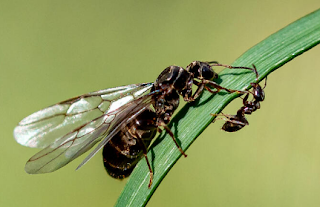Flying Ants: Harmless or Dangerous?
Winged ants are an uncommon phenomena that begs many questions. Some individuals are so anxious about the winged crawlers that their alarm bells are even ringing. When the eerie insects start to gather in large groups, you start to think you're in a scary movie. We describe the significance of the enigmatic flying ants.
 |
| iStock |
Where do flying ants come from?
First and foremost, ants with wings are just regular ants. They are bigger than the typical examples of their sort, though. They are primarily members of the yellow or black-grey garden ant species here (Lasius flavus or niger). The males and females with wings are sexually mature individuals who were selected at birth to found new ant colonies.
The few eggs deposited by the queen develop into what are known as "sex animals," whereas the workers, guards, and soldiers in the ant colony remain essentially sterile. Unfertilized eggs give rise to males, while fertilised eggs produce females. These animals are raised in a stately manner in the den and consequently develop into stately creatures. Wings are exclusive to these particular sex animals.
The ants' wings serve only one function: to spread. Only when they have enough partners to mate with do the males and females fly far enough to establish a new colony. When the July weather is dry, warm, and windless, the winged ants wait in their home hive until that day. In numerous colonies, the ant nuptial flight occurs simultaneously. Then, all flying ants of one species swing into the air simultaneously, as though in response to an invisible signal. This is how the enormous, impressively sized swarms of winged gigantic ants congregate. During this nuptial flight, each female mates with a number of males. She saves the seed for later use.
Are flying ants dangerous?
In the home and yard, flying ants are absolutely non-aggressive and harmless. Finding other ants is the only objective of the insects. Individual animals enjoy getting lost in living rooms, drawn by the light, but sadly, people and their homes are frequently in the way. However, flying ants are not harmful. They don't bite, sting, or harm objects. There is no need to attack the animals because the ants are not actually a problem and are not hostile.
However, since the females will eventually become queens, it is best to prevent them from looking for a nesting location indoors. Put the insects back outdoors and use fly screens to secure the windows and entrances. By the way, the fright passes just as rapidly as summer's flying insects. After a few days, the animals stop their protracted quest for a mate and leave the area. After mating, the males perish. The females become the queens of their own colonies after biting off their wings.

Comments
Post a Comment